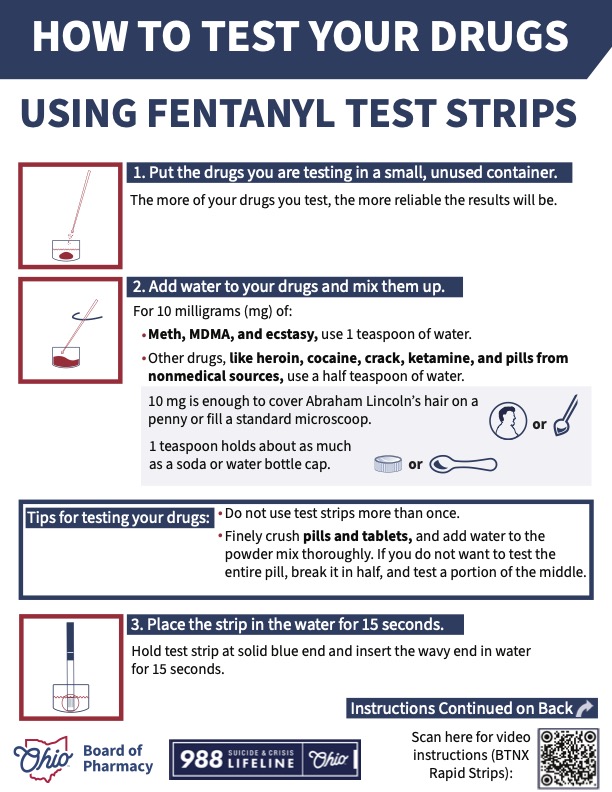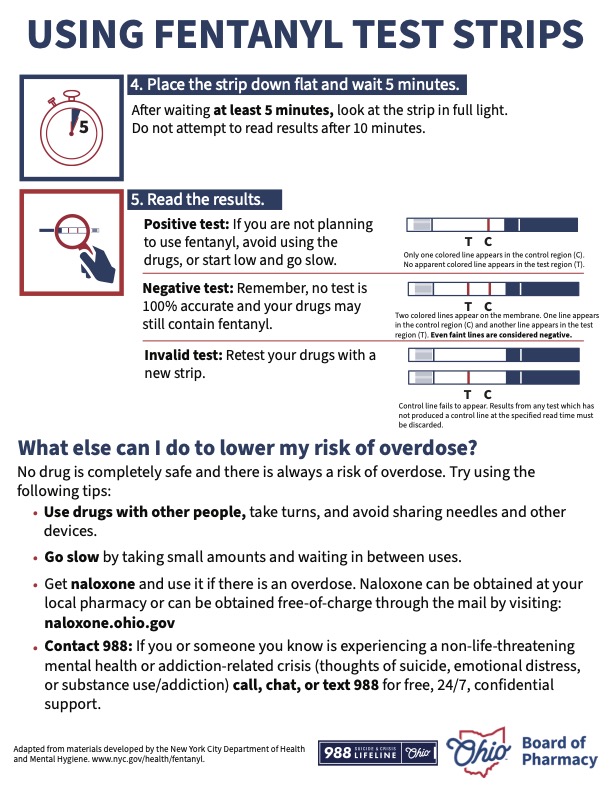Here are some things to know about the opioid fentanyl, and how harm reduction tactics can reduce its impact.
1. Fentanyl is an opioid 50 times more potent than heroin.
Opioids are pain killers that people sometimes use recreationally for their euphoria and relaxation effects. Fentanyl has medical uses, primarily to control severe pain after surgery and in advanced-stage cancer treatment.
Outside of medical settings, fentanyl appears as a white powder. It is also used to cut drugs, meaning it’s mixed with other substances to make the quantity of the secondary substance stretch.
2. Illegal fentanyl use and abuse affects everyone.
Although most often used to cut powdered opiates, fentanyl is also used to cut pills and drugs like cocaine, ketamine, methamphetamines (like ADHD pills), and benzodiazepines (like Xanax).
Even if you don’t use opiates, or any drugs at all, you probably know someone who has been affected by addiction and overdose deaths. A 2024 survey from the RAND Corporation reported that more than 42% of adults in the US know someone who has died from an overdose. So even if you don’t have a firsthand connection to this widespread social problem, you probably know someone who does.
3. It’s impossible to die, to become intoxicated, or to become addicted to fentanyl simply by touching it in powdered form.
There’s a lot of misinformation and disinformation about fentanyl, and it’s important to separate facts from myths.
4. Fentanyl is very dangerous, but there are harm reduction tools that can limit its impact.
Two important harm reduction tools are the medication naloxone (also known by its brand name Narcan) and fentanyl test strips.
The effects of fentanyl (and all opioids) can be blocked and reversed with the use of Narcan. Anyone can purchase Narcan over the counter, and there are places that give it away for free (see below). It comes in a nasal spray or as an injectable.
Drug users can also use fentanyl test strips to determine if a product has been cut with fentanyl.
That said, while test strips are helpful, they’re not 100% effective. For drugs in pill forms, you might be testing a part of the pill that doesn’t have fentanyl in it. If you test one pill from a bottle or bag of pills, that one dose might not have fentanyl in it, but the others might.
There are three primary ways that test strips work:
- Method 1: Dissolve all of the drug you want to use in clean water. If testing pills, the most accurate way includes finely crushing all of them. You can wait for the water to evaporate, or drink the solution after testing.
- Method 2: Use the residue in the bag used to store the drug. Add water to the bag after putting the drugs to the side. If testing pills, the more accurate way is to finely crush all of them and then add that to a bag. Shake the bag beforehand to make sure any possible fentanyl is distributed throughout for a more accurate reading.
- Method 3: Use 10mg of the drug you want to test. If you can’t measure 10mg, use a few grains of the substance. 10mg is roughly the amount of Abe Lincoln’s hair on a penny if you have one. For 10mg of meth or MDMA (aka ecstasy or molly) to test, use 1 teaspoon of water, which is about 1 bottle cap full. For 10mg of any other drug you want to test, use ½ teaspoon of water.
For all methods, insert the test strip with the wavy side down for 15 seconds. Do not place the test strip past the blue line. Place the strip on a flat surface and wait two minutes for results.
A positive test has one pink line on the side of the strip, farthest away from the testing end. A negative test has two pink lines. If neither of these are your readings, the test is inconclusive, and it might be helpful to test again.
Here is a helpful document from Ohio’s Board of Pharmacy that illustrates how these tests work. (It is also available as a readable PDF, in both English and Spanish.)


You can pick up Narcan and testing strips at a Maryland State Overdose Response Program, or similar programs in other states. Here are some locations close to Hopkins campuses:
- Homewood: Project Connections at the Behavioral Health Leadership Institute, Inc. 2601 N. Howard Street, Suite 240, Baltimore, MD 21218. Fax: 410-367-5879.
- East Baltimore: Lighthouse Studies at Peer Point. 2213 McElderry St, 2nd Floor Baltimore, MD 21205. 1-800-967-5710; Maryland Peer Advisory Council (MPAC), 2233 Orleans Street Baltimore, MD 21231. 410-357-1103.
- Harbor East: Behavioral Health System Baltimore 100 South Charles Street, Tower 2, 8th Floor,
Baltimore, MD, 21201. 410-637-1900. - DC: There’s a vending machine at DC Fire and Emergency Medicine Station, 500 F Street NW, Washington, DC, 20001.
Baltimore City Harm Reduction Coalition, located at 116 E. 25th Street, Baltimore, MD 21218, also provides harm reduction items on 116 E 25th Street
5. There are additional harm reduction techniques that can keep users safer.
Go low and slow. You can always take more of a substance, but you can’t take less. There are many things that can impact intoxication, overdose and bad reactions like feeling tired, being sick, or different emotional states.
Don’t mix substances. Substances can mask or enhance the effects of others making it harder to gauge how intoxicated you are.
Don’t use alone. If something goes wrong having another person around can be helpful. The Amnesty policy applies for all substance use emergencies if you call Campus Safety and Security (410-516-7777), 9-1-1, or if you’re on-campus, contact an RA on duty, stay with the person in need, and cooperate with first responders.
Always have materials (Narcan and the testing strips) and emergency numbers handy. If you suspect someone is having a fentanyl or other opioid overdose, you can administer Narcan to try and revive them. Even if you aren’t 100% sure, Narcan will not hurt the person if they aren’t experiencing an opioid overdose. After administering Narcan, it is still helpful to call for medical help.
Categories
- Environmental (69)
- Financial (64)
- Mental (221)
- Physical (310)
- Professional (182)
- Sexual (84)
- Social (188)
- Spiritual (26)
Archives
- October 2025
- September 2025
- August 2025
- July 2025
- May 2025
- April 2025
- March 2025
- February 2025
- January 2025
- December 2024
- November 2024
- October 2024
- September 2024
- August 2024
- July 2024
- May 2024
- April 2024
- March 2024
- February 2024
- January 2024
- December 2023
- November 2023
- October 2023
- September 2023
- August 2023
- June 2023
- May 2023
- April 2023
- March 2023
- February 2023
- January 2023
- December 2022
- November 2022
- October 2022
- September 2022
- August 2022
- July 2022
- June 2022
- May 2022
- April 2022
- March 2022
- February 2022
- January 2022
- December 2021
- November 2021
- October 2021
- September 2021
- August 2021
- July 2021
- June 2021
- May 2021
- April 2021
- March 2021
- February 2021
- January 2021
- December 2020
- November 2020
- October 2020
- September 2020
- August 2020
- July 2020
- June 2020